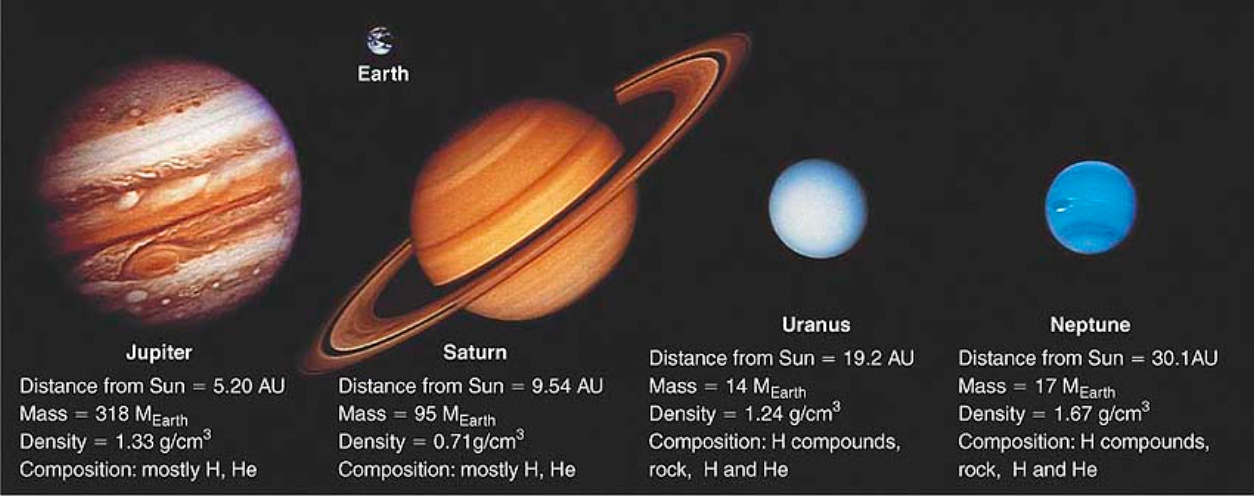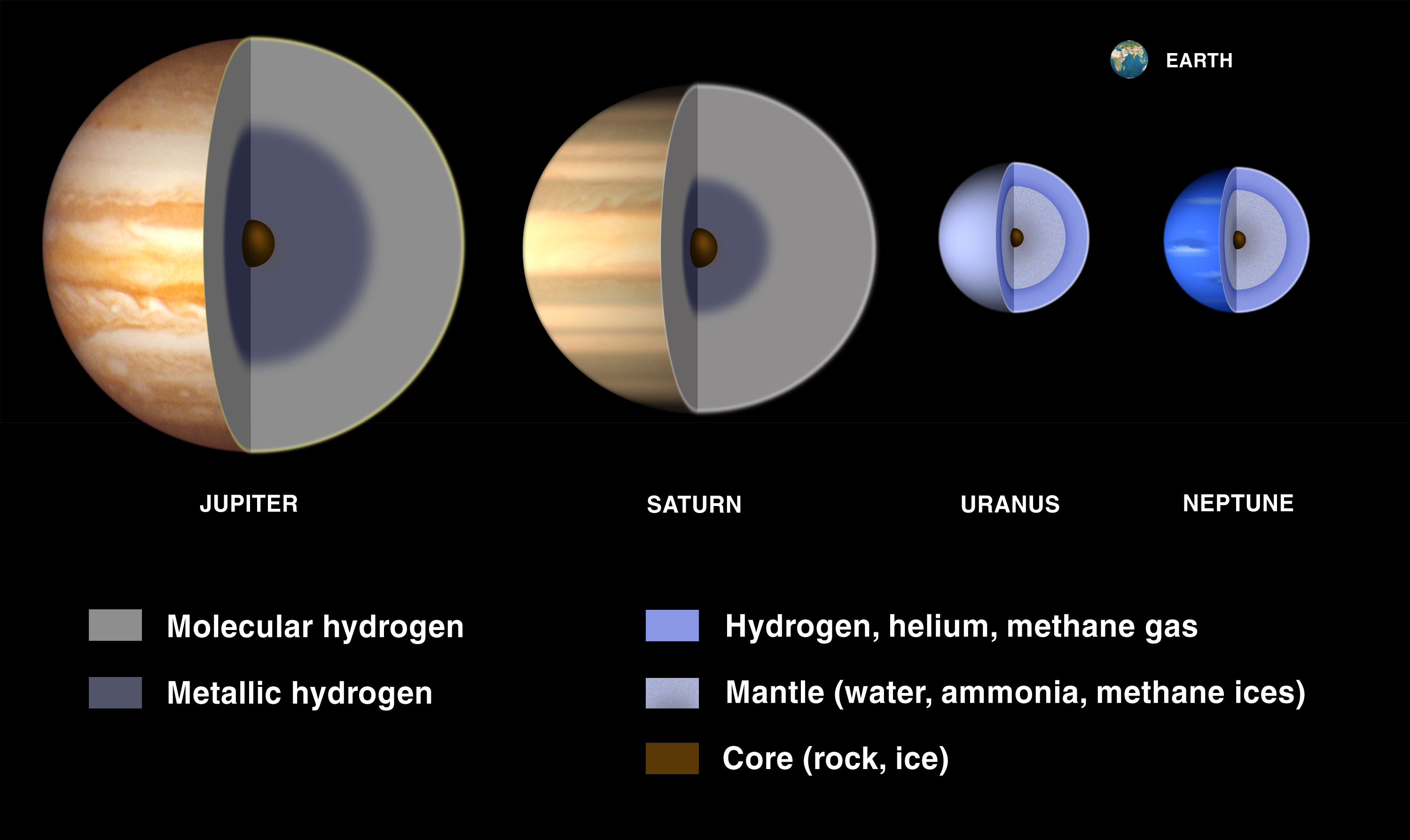Which Best Describes Jupiter Saturn Uranus and Neptune
Nearly twins in terms of size about 4x diameter of Earth. Which statement best describes plate motion in the area during the.

The Outer Planets Giant Planets What Are They And Where Are They
AVenus BNeptune CSaturn DUranus 2Which of the following statements about the beginning of the solar system.

. Composition and density similar to Jupiter and Saturn. Describe the four outer planets Jupiter Saturn Neptune and Uranus as well as the dwarf planet Pluto To unlock this lesson you must. 2 days agoFor the past couple of decades NASA has been investing in spacecraft to conduct up-close examinations of Mercury Venus Mars Jupiter and Saturn.
Which of the following best explains why Jupiters density is higher than Saturns. Jupiter is first among the planets in terms of size and mass. Uranus is the seventh planet from the Sun.
Select two options. All four planets have essentially the same composition. Jupiter is more massive than Saturn Based on the leading scientific theory of solar system formation which of the following statements best explains why Uranus and Neptune have a significantly different composition than Jupiter and Saturn.
There are two ice giants in the Solar System. Jupiter Saturn UranusNeptune The metallic hydrogen is a superconductor. Jupiter is made mostly of hydrogen Saturn is made mostly of helium Uranus is made mostly of hydrogen compounds and Neptune is made mostly of rock.
Neptune Uranus Saturn and Jupiter are the gas giants of our solar system. Which of the following statements best describes the general pattern of composition among the four Jovian planets. The jovian planets share many characteristics in common such as approximate core size severe weather rings and numerous moons and strong magnetic fields.
Rotate in 17 hrs. Atmospheres have subtle bands strong winds storms. Uranus and Neptune are gas giant planets whereas Jupiter and Saturn are terrestrial-type planets.
Io and Europa are two of Jupiters many moons. A superconductor conduct electricity with minimum or no resistance. Jupiter Neptune Saturn Uranus Venus 2 See answers An ice giant is a giant planet composed mainly of elements heavier than hydrogen and helium such as oxygen carbon nitrogen and sulfur.
The mean distance of Europa from Jupiter is about twice as. It has the third-largest planetary radius and fourth-largest planetary mass in the Solar System. The Great Red Spot on Jupiter is actually a.
Out of the four Jovian Planets Jupiter and Saturn are larger than Neptune and Uranus revealing that the two pairs have different compositions. Made mostly of gas they include Jupiter Saturn Uranus and Neptune. Look at the densities of the Jovian planets given in Figure 1.
Now itll likely be Uranus turn. The outer planets are denser than the inner planets. Saturn is dense but the other outer planets are not.
Its presence is important to justify the strong magnetic field of Jupiter and Saturn Increasing temperature and pressure deeper in core Jupiter shape is distorted about 7 larger at equator. Jovian planet composition and densities. He came to this conclusion by using several different starting positions and ran computer simulations using the four gas planets - Jupiter Saturn Uranus and Neptune - but discovered they were to.
All the outer planets have low density. Its diameter is 11 times bigger than Earth and its mass is 25 times greater than all the other planets combined. Uranus and Neptune contain relatively more rock and hydrogen compounds than Jupiter and Saturn.
Which statement best describes the density of the outer planets. Jupiter and Saturn only-interior is mostly liquid or metallic hydrogen-composed mostly of hydrogen and helium Uranus and Neptune only-blue color because of methane-composed mostly hydrogen compounds all four jovian planets-approximately 10 Earth-mass core-orbited by rings of ice and rock-magnetic field stronger than Earths. Jupiter and Saturn only-interior is mostly liquid or metallic hydrogen-composed mostly of hydrogen and helium Uranus and Neptune only-blue color because of methane-composed mostly hydrogen compounds all four jovian planets-approximately 10 Earth-mass core-orbited by rings of ice and rock-magnetic field stronger than Earths.
Jupiter and Saturn only-interior is mostly liquid or metallic hydrogen-composed mostly of hydrogen and helium Uranus and Neptune only-blue color because of methane-composed mostly hydrogen compounds all four jovian planets-approximately 10 Earth-mass core-orbited by rings of ice and rock-magnetic field stronger than Earths. Its name is a reference to the Greek god of the sky Uranus who according to Greek mythology was the great-grandfather of Ares Mars grandfather of Zeus Jupiter and father of Cronus Saturn. Unlike Jupiter and Saturn Uranus and Neptune have layers of.
Uranus and Neptune were able to attract much more hydrogen and helium than Jupiter and Saturn did so Uranus and Neptune have much thicker atmospheres. Jupiter and Saturn have compositions that are fairly different from the compositions of Uranus and Neptune. Uranus and Neptune are dense but Jupiter and Saturn are not.
These four planets are also called the Jovian Planets after Jupiter because they reside in the outer part of our solar system past the asteroid belt and past Mars. View exam_2_review_ from AST MISC at Park University. Jupiter and Saturn have similar compositions of hydrogen and helium while Uranus and Neptune are composed primarily of hydrogen compounds.

Gas Giant Interiors 2003 Nasa Solar System Exploration

No comments for "Which Best Describes Jupiter Saturn Uranus and Neptune"
Post a Comment